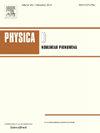Numerical evaluations of quasi-periodic wave solutions to two supersymmetric integrable equations
IF 2.9
3区 数学
Q1 MATHEMATICS, APPLIED
引用次数: 0
Abstract
A new algorithm named global Levenberg–Marquardt (LM) algorithm is proposed to explicitly construct quasi-periodic wave solutions of the supersymmetric integrable systems, which combines the super Riemann theta functions and Hirota’s bilinear method. In particular, the numerical quasi-periodic wave solutions for the supersymmetric KdV–Sawada–Kotera–Ramani equation and supersymmetric Ito’s equation are investigated. The quasi-periodic wave solvability problem is successfully transformed into a system of over-determined equations, which can be formulated into a least square problem and then solved by using the global LM algorithm. The quasi-periodic wave solutions can be classified into two categories including quasi-periodic parallel waves and quasi-periodic cross waves. A distinct analysis of the factors that influence the emergence of “influencing band” and the bandwidth of “influencing band” is presented. Furthermore, by using an analytical method related to the characteristic lines for the quasi-periodic waves, the dynamic characteristics including the periods, wave propagation direction, peak points, trough points, velocities and the distance between two peaks can be intuitively displayed. In addition, based on the small amplitude limit method, the asymptotic properties of -periodic waves to the supersymmetric integrable systems are presented.
两个超对称可积方程拟周期波解的数值计算
将超黎曼函数与Hirota双线性方法相结合,提出了一种明确构造超对称可积系统拟周期波解的全局Levenberg-Marquardt (LM)算法。特别地,研究了超对称KdV-Sawada-Kotera-Ramani方程和超对称Ito方程的数值拟周期波解。将拟周期波可解性问题转化为一个超定方程组,并将其转化为最小二乘问题,利用全局LM算法求解。拟周期波解可分为拟周期平行波和拟周期交叉波两类。对影响“影响带”产生的因素和“影响带”的带宽进行了清晰的分析。此外,利用准周期波特征线的解析方法,可以直观地显示准周期波的周期、波的传播方向、波峰点、波谷点、速度和两峰之间的距离等动态特性。此外,基于小振幅极限方法,给出了n周期波对超对称可积系统的渐近性质。
本文章由计算机程序翻译,如有差异,请以英文原文为准。
求助全文
约1分钟内获得全文
求助全文
来源期刊

Physica D: Nonlinear Phenomena
物理-物理:数学物理
CiteScore
7.30
自引率
7.50%
发文量
213
审稿时长
65 days
期刊介绍:
Physica D (Nonlinear Phenomena) publishes research and review articles reporting on experimental and theoretical works, techniques and ideas that advance the understanding of nonlinear phenomena. Topics encompass wave motion in physical, chemical and biological systems; physical or biological phenomena governed by nonlinear field equations, including hydrodynamics and turbulence; pattern formation and cooperative phenomena; instability, bifurcations, chaos, and space-time disorder; integrable/Hamiltonian systems; asymptotic analysis and, more generally, mathematical methods for nonlinear systems.
 求助内容:
求助内容: 应助结果提醒方式:
应助结果提醒方式:


